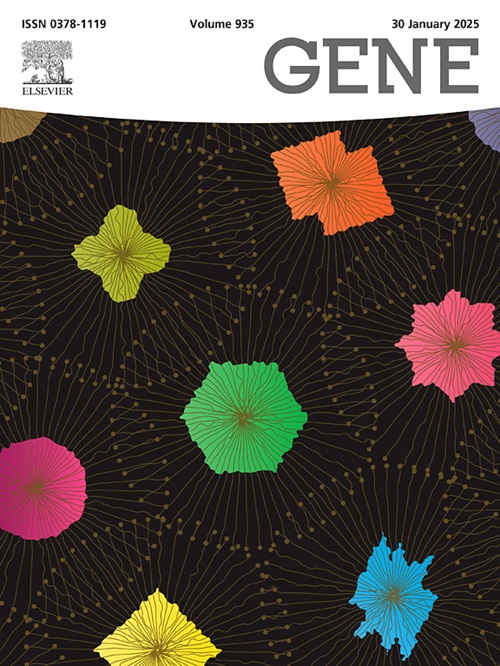Revealing the key aromatic compounds in Malus ’Lollipop’ flowers by transcriptome and metabolome
IF 2.6
3区 生物学
Q2 GENETICS & HEREDITY
引用次数: 0
Abstract
The ornamental crabapple Malus (M.) ’Lollipop’ is renowned for its compact growth and fragrant flowers. This study aims to elucidate the biosynthesis molecular mechanism of volatile organic compounds (VOCs) across four developmental stages of the M. ’Lollipop’ flowers using metabolomics and transcriptomics analyses. Gas chromatography-mass spectrometry (GC–MS) identified 29 VOCs (aliphatic derivatives, benzenes, and alkanes) in M. ’Lollipop’ flowers. Orthogonal Partial Least Squares Discriminant Analysis (OPLS-DA) analysis highlights 14 key differential aromatic compounds (VIP ≥ 1), featuring (Z)-3-hexen-1-yl acetate in stage 1, methyl benzoate in stage 2, benzyl alcohol and linalool in stage 3, and camphene and (Z)-3-hexen-1-ol in stage 4. (Z)-3-hexen-1-yl acetate was identified as a co-primary constituent in the four flowering stages, designated as a key and floral contributing metabolite (variable importance in projection (VIP) ≥ 1& odor activity value (OAV) ≥ 1). RNA sequencing revealed key genes including CAT, DXS, MVD, HMGCR, FDPS, and TPSc in camphene and linalool synthesis, aroA, ADT, PDT, PAL, BEBT1, SDR, 4CL, CNL, and BALDH for benzyl alcohol, benzaldehyde, and methyl benzoate production. And PLA2G, SPLA2, TGL4, LOX2S and ADH1 in (Z)-3-hexen-1-yl acetate and (Z)-3-hexen-1-ol synthesis. 24 transcription factors (TFs) were predicted to be closely linked to genes involved in VOC synthesis. The findings above deepen our comprehension of the floral scent in crabapple, laying a foundation for further investigations into their functions and potential industrial applications.
通过转录组和代谢组揭示苹果“棒棒糖”花中的关键芳香化合物。
观赏海棠(M.)“棒棒糖”以其紧凑的生长和芳香的花朵而闻名。本研究旨在阐明M的四个发育阶段挥发性有机化合物(VOCs)的生物合成分子机制。使用代谢组学和转录组学分析的“棒棒糖”花。气相色谱-质谱联用技术(GC-MS)鉴定出29种挥发性有机化合物(脂肪族衍生物、苯和烷烃)。“棒棒糖”的花。正交偏最小二乘判别分析(OPLS-DA)分析发现了14个关键的差异芳香族化合物(VIP≥1),其中(Z)-3-己烯-1-乙酸酯在第1阶段,苯甲酸甲酯在第2阶段,苯甲醇和芳樟醇在第3阶段,莰烯和(Z)-3-己烯-1-醇在第4阶段。(Z)-3-己烯-1-乙酸酯被鉴定为四个花期的共同主要成分,被指定为关键的和对花有贡献的代谢物(投影变量重要度(VIP)≥1和气味活性值(OAV)≥1)。RNA测序显示,camphene和芳樟醇合成的关键基因包括CAT、DXS、MVD、HMGCR、FDPS和TPSc,苯甲醇、苯甲醛和苯甲酸甲酯合成的关键基因包括aroA、ADT、PDT、PAL、BEBT1、SDR、4CL、CNL和BALDH。PLA2G, SPLA2, TGL4, LOX2S和ADH1在(Z)-3-己烯-1-乙酸酯和(Z)-3-己烯-1-醇合成中。预计有24个转录因子(TFs)与参与VOC合成的基因密切相关。这些发现加深了我们对海棠花香的认识,为进一步研究海棠花香的功能和潜在的工业应用奠定了基础。
本文章由计算机程序翻译,如有差异,请以英文原文为准。
求助全文
约1分钟内获得全文
求助全文
来源期刊

Gene
生物-遗传学
CiteScore
6.10
自引率
2.90%
发文量
718
审稿时长
42 days
期刊介绍:
Gene publishes papers that focus on the regulation, expression, function and evolution of genes in all biological contexts, including all prokaryotic and eukaryotic organisms, as well as viruses.
 求助内容:
求助内容: 应助结果提醒方式:
应助结果提醒方式:


